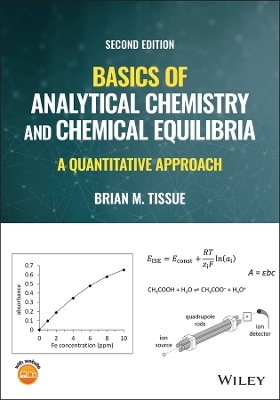
Basics of Analytical Chemistry and Chemical Equilibria
John Wiley & Sons Inc (Verlag)
978-1-119-70735-6 (ISBN)
- Titel ist leider vergriffen;
keine Neuauflage - Artikel merken
Analytical chemistry is the study of chemical composition, concerned with analyzing materials to discover their constituent substances, the amounts in which these substances are present, and more. Since materials exist in different states and undergo reactions, analytical chemistry is also concerned with chemical equilibria, the state at which various reactants and substances will undergo no observable chemical change without outside stimulus. This field has an immense range of practical applications in both industry and research and is a highly desirable area of expertise for the next generation of chemists.
Basics of Analytical Chemistry and Chemical Equilibria provides an introduction to this foundational subject, ideal for specialized courses. It introduces not only the core concepts of analytical chemistry but cultivates mastery of various instrumental methods by which students and researchers can undertake their own analyses. Now updated to include the latest research and expanded coverage, Basics of Analytical Chemistry and Chemical Equilibria promises to situate a new generation of readers in this growing field.
Readers of the second edition of Basics of Analytical Chemistry and Chemical Equilibria will also find:
A new chapter on structure determination
Revised and expanded descriptions of chemical instrumentation
‘You-try-it’ exercises throughout to further develop practical student knowledge
Compannion website of associated materials including end-of-chapter solutions, spreadsheets for student use, and more
Basics of Analytical Chemistry and Chemical Equilibria is an ideal textbook for students in chemistry, biochemistry, and environmental science, as well as students in related fields, including chemical engineering and materials science, for whom analytical chemistry offers a useful toolset.
Brian M. Tissue, PhD is an Associate Professor of Chemistry at Virginia Tech, Blacksburg, VA, USA. He teaches instrumental analysis and his awards and honors include an NSF Career Award and a Cottrell Scholar Award from the Research Corporation for Science Advancement.
Preface ix
About the Companion Website xiii
I Quantitative Analysis Using Reactions That Go to “completion” 1
1 Making Measurements 3
1.1 Introduction 3
1.2 Glp and a Few Other Important Acronyms 10
1.3 Precision and Random Error 14
1.4 Discarding a Suspected Outlier 25
1.5 Calibration 28
1.6 Maintaining Accurate Results 44
Practice Exercises 49
2 Sample Preparation, Extractions, and Chromatography 53
2.1 Sampling and Control Samples 53
2.2 Sample Preparation 59
2.3 Solvents and Solutions 65
2.4 Introduction to Solubility 69
2.5 Extraction and Partitioning Theory 72
2.6 Introduction to Stationary Phases 84
2.7 Solid-Phase Extraction (SPE) 88
2.8 Column Chromatography 94
Practice Exercises 97
3 Classical Methods 103
3.1 Introduction 103
3.2 Review of Chemical Reactions 105
3.3 Reactions in Aqueous Solution 112
3.4 Gravimetry 121
3.5 Titration 125
3.6 Titration Curves 133
3.7 Coulometry 135
Practice Exercises 138
4 Molecular Spectroscopy 143
4.1 Introduction 143
4.2 Properties of EM Radiation 144
4.3 Electromagnetic Spectrum 148
4.4 Spectroscopic Transitions 150
4.5 UV Vis Absorption Spectroscopy 155
4.6 UV Vis Instrumentation 158
4.7 Beer–Lambert Law 161
4.8 Molecular Fluorescence 170
Practice Exercises 178
II Reactions That Do Not Go to “completion.” Equilibria in Aqueous Solutions 183
5 Acid–base Equilibria and Activity 185
5.1 Acids and Bases 185
5.2 Weak Acids and Weak Bases 192
5.3 Water and Kw 197
5.4 Acid Strength 202
5.5 The Concept of Activity 207
5.6 Acid–Base Equilibrium Calculations 219
Practice Exercises 225
6 Buffer Solutions and Polyprotic Acids 229
6.1 Buffer Solutions 229
6.2 Alpha Fraction Plots 234
6.3 Weak Acid Titration Curve 238
6.4 Polyprotic Acids 241
Practice Exercises 250
7 Metal–ligand Complexation 253
7.1 Complex Terminology 254
7.2 Complex Equilibria 258
7.3 Competing Equilibria 264
7.4 Stepwise Complexation 271
7.5 Immunoassays 276
Practice Exercises 279
8 Precipitation Equilibria 283
8.1 Precipitate Equilibrium 284
8.2 Molar Solubility 291
8.3 Common-Ion Effect 297
8.4 Precipitation and Competing Equilibria 299
8.5 Drinking Water 304
Practice Exercises 306
III Instrumental Methods and Analytical Separations 311
9 Electroanalytical Chemistry 313
9.1 Introduction 313
9.2 Standard Reduction Potentials 316
9.3 Using Half Reactions 321
9.4 Background on Spontaneous Reactions and Equilibrium 327
9.5 Reaction Energies, Voltages, and the Nernst Equation 331
9.6 Electrochemical Cells 334
9.7 Potentiometry 340
9.8 Ion-Selective Electrodes (ISE) 342
9.9 Voltammetry 350
Practice Exercises 358
10 Atomic Spectrometry 361
10.1 Atomization 363
10.2 Atomic Absorption Spectrometry (AAS) 368
10.3 Atomic Emission Spectrometry (AES) 378
10.4 Inductively Coupled Plasma Mass Spectrometry (ICP-MS) 381
10.5 Other Mass Spectrometer Designs 390
Practice Exercises 395
11 Molecular Structure Determination 399
11.1 Introduction 399
11.2 Molecular Mass Spectrometry 402
11.3 Fourier-Transform Infrared Spectroscopy 407
11.4 FTIR Instrumentation 412
11.5 Nuclear Magnetic Resonance Spectroscopy 416
11.6 NMR Instrumentation 421
Practice Exercises 424
12 Analytical Separations 425
12.1 Thin-Layer Chromatography 426
12.2 Chromatogram Terminology 431
12.3 Separation Efficiency 435
12.4 Gas Chromatography (GC) 439
12.5 Gas Chromatography Mass Spectrometry (GC-MS) 444
12.6 High Performance Liquid Chromatography 447
12.7 Electrophoresis 460
Practice Exercises 464
Index 469
| Erscheinungsdatum | 06.03.2023 |
|---|---|
| Verlagsort | New York |
| Sprache | englisch |
| Maße | 178 x 252 mm |
| Gewicht | 816 g |
| Themenwelt | Naturwissenschaften ► Biologie |
| Naturwissenschaften ► Chemie | |
| ISBN-10 | 1-119-70735-8 / 1119707358 |
| ISBN-13 | 978-1-119-70735-6 / 9781119707356 |
| Zustand | Neuware |
| Haben Sie eine Frage zum Produkt? |
aus dem Bereich


